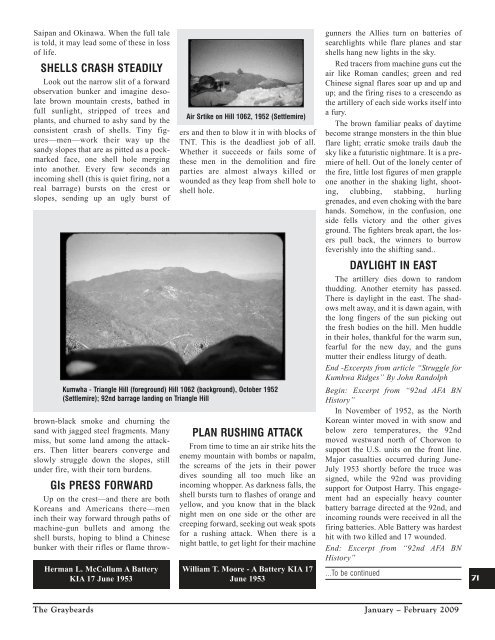Jan/Feb 2009 - Korean War Veterans Association
Jan/Feb 2009 - Korean War Veterans Association
Jan/Feb 2009 - Korean War Veterans Association
Create successful ePaper yourself
Turn your PDF publications into a flip-book with our unique Google optimized e-Paper software.
Saipan and Okinawa. When the full tale<br />
is told, it may lead some of these in loss<br />
of life.<br />
SHELLS CRASH STEADILY<br />
Look out the narrow slit of a forward<br />
observation bunker and imagine desolate<br />
brown mountain crests, bathed in<br />
full sunlight, stripped of trees and<br />
plants, and churned to ashy sand by the<br />
consistent crash of shells. Tiny figures—men—work<br />
their way up the<br />
sandy slopes that are as pitted as a pockmarked<br />
face, one shell hole merging<br />
into another. Every few seconds an<br />
incoming shell (this is quiet firing, not a<br />
real barrage) bursts on the crest or<br />
slopes, sending up an ugly burst of<br />
brown-black smoke and churning the<br />
sand with jagged steel fragments. Many<br />
miss, but some land among the attackers.<br />
Then litter bearers converge and<br />
slowly struggle down the slopes, still<br />
under fire, with their torn burdens.<br />
Air Srtike on Hill 1062, 1952 (Settlemire)<br />
GIs PRESS FORWARD<br />
Up on the crest—and there are both<br />
<strong>Korean</strong>s and Americans there—men<br />
inch their way forward through paths of<br />
machine-gun bullets and among the<br />
shell bursts, hoping to blind a Chinese<br />
bunker with their rifles or flame throwers<br />
and then to blow it in with blocks of<br />
TNT. This is the deadliest job of all.<br />
Whether it succeeds or fails some of<br />
these men in the demolition and fire<br />
parties are almost always killed or<br />
wounded as they leap from shell hole to<br />
shell hole.<br />
Kumwha - Triangle Hill (foreground) Hill 1062 (background), October 1952<br />
(Settlemire); 92nd barrage landing on Triangle Hill<br />
Herman L. McCollum A Battery<br />
KIA 17 June 1953<br />
PLAN RUSHING ATTACK<br />
From time to time an air strike hits the<br />
enemy mountain with bombs or napalm,<br />
the screams of the jets in their power<br />
dives sounding all too much like an<br />
incoming whopper. As darkness falls, the<br />
shell bursts turn to flashes of orange and<br />
yellow, and you know that in the black<br />
night men on one side or the other are<br />
creeping forward, seeking out weak spots<br />
for a rushing attack. When there is a<br />
night battle, to get light for their machine<br />
William T. Moore - A Battery KIA 17<br />
June 1953<br />
gunners the Allies turn on batteries of<br />
searchlights while flare planes and star<br />
shells hang new lights in the sky.<br />
Red tracers from machine guns cut the<br />
air like Roman candles; green and red<br />
Chinese signal flares soar up and up and<br />
up; and the firing rises to a crescendo as<br />
the artillery of each side works itself into<br />
a fury.<br />
The brown familiar peaks of daytime<br />
become strange monsters in the thin blue<br />
flare light; erratic smoke trails daub the<br />
sky like a futuristic nightmare. It is a premiere<br />
of hell. Out of the lonely center of<br />
the fire, little lost figures of men grapple<br />
one another in the shaking light, shooting,<br />
clubbing, stabbing, hurling<br />
grenades, and even choking with the bare<br />
hands. Somehow, in the confusion, one<br />
side fells victory and the other gives<br />
ground. The fighters break apart, the losers<br />
pull back, the winners to burrow<br />
feverishly into the shifting sand..<br />
DAYLIGHT IN EAST<br />
The artillery dies down to random<br />
thudding. Another eternity has passed.<br />
There is daylight in the east. The shadows<br />
melt away, and it is dawn again, with<br />
the long fingers of the sun picking out<br />
the fresh bodies on the hill. Men huddle<br />
in their holes, thankful for the warm sun,<br />
fearful for the new day, and the guns<br />
mutter their endless liturgy of death.<br />
End -Excerpts from article “Struggle for<br />
Kumhwa Ridges” By John Randolph<br />
Begin: Excerpt from “92nd AFA BN<br />
History”<br />
In November of 1952, as the North<br />
<strong>Korean</strong> winter moved in with snow and<br />
below zero temperatures, the 92nd<br />
moved westward north of Chorwon to<br />
support the U.S. units on the front line.<br />
Major casualties occurred during June-<br />
July 1953 shortly before the truce was<br />
signed, while the 92nd was providing<br />
support for Outpost Harry. This engagement<br />
had an especially heavy counter<br />
battery barrage directed at the 92nd, and<br />
incoming rounds were received in all the<br />
firing batteries. Able Battery was hardest<br />
hit with two killed and 17 wounded.<br />
End: Excerpt from “92nd AFA BN<br />
History”<br />
...To be continued<br />
71<br />
The Graybeards<br />
<strong>Jan</strong>uary – <strong>Feb</strong>ruary <strong>2009</strong>

















